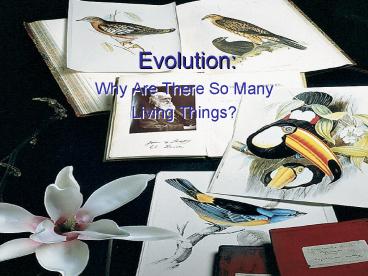Evolution: - PowerPoint PPT Presentation
1 / 19
Title:
Evolution:
Description:
Major points of Darwin's theories of evolution and natural selection ... Major points of Darwin's theories of evolution and natural selection. Second observation: ... – PowerPoint PPT presentation
Number of Views:24
Avg rating:3.0/5.0
Title: Evolution:
1
Evolution
- Why Are There So Many
- Living Things?
2
Where Did the Idea of Evolution Come From?
- Middle Ages
- Ladder of Life
- Complex organisms found at highest rungs
- Less complex at lower rungs
- 1800s
- Georges Cuvier brought study of fossils to the
level of science.
3
Where Did the Idea of Evolution Come From?
- Charles Lyell
- Proposed theory of uniformitarianism.
- Jean-Baptiste Lamarck
- Published theory of the inheritance of acquired
characteristics.
4
Charles Darwin
- Loved nature
- Studied medicine
- Struggled with the inhumane operating procedures
- Switched to religion
- Offered position as naturalist on British survey
ship, The Beagle.
5
Voyage around the World
- Studied animals and fauna.
- Noticed South American fossils differed from
contemporaries. - Collected data for 27 years to support his
mechanism for evolution.
6
Fathers of Evolution
- Alfred Wallace studied in Brazil and East Indies.
- Developed mechanism of evolution independently of
Darwin. - Sent a copy of it to Darwin.
- Contained same conclusions as Darwin
- Both presented their data at Linnaean Society of
London in July 1858.
7
How Did Darwin Account for Species?
- In Origin of Species, he developed two main
concepts - Evidence that evolutions has occurred.
- Mechanism for evolution natural selection.
8
Major points of Darwins theories of evolution
and natural selection
- First observation
- Populations have the potential to increase
exponentially. - Based on thoughts by Thomas Malthus
9
Major points of Darwins theories of evolution
and natural selection
- Second observation
- Populations are fairly constant in size.
10
Major points of Darwins theories of evolution
and natural selection
- Third observation
- Natural resources are limited.
- Limited amount of space, nutrients, shelter
- Results in competition for resources to survive.
11
Major points of Darwins theories of evolution
and natural selection
- Deduction one
- Only some organisms survive. There is a struggle
for existence among individuals in a population. - Organisms posses characteristics that enhance
survival - Called adaptations.
12
Three Types of Adaptations
- Morphological-anatomical modifications in form
and structure that enhance survival. - Biochemical-physiological modifications in the
production and use of chemicals by organisms. - Behavioral Adaptations Modifications in animal
interactions with others and environment.
13
Major points of Darwins theories of evolution
and natural selection
- Fourth observation
- There is variation within individuals of a
population and variations are inherited.
14
Major points of Darwins theories of evolution
and natural selection
- Deduction two
- Individuals with favorable variations are more
likely to survive and reproduce. - Natural Selection
- preservation of favorable variations and the
rejection of injurious variations
15
Major points of Darwins theories of evolution
and natural selection
- Deduction three
- Accumulation of inheritable variation over many
generations is evolution. - If changes within a species become great enough,
a new species can result.
16
What is a species?
- Species are considered extinct if they do not
interbreed in nature. - Implies offspring must also be able to reproduce.
17
Evidence supporting Theory of Evolution
- Selective breeding practices used by farmers
result in - improved domesticated plants and animals.
- Darwin wondered if nature could do the same.
18
Evidence supporting theory of evolution
- Fossil record
- Comparing fossils from ancestors with todays
species demonstrates species have evolved.
19
Evidence supporting theory of evolution
- Homologous structures
- Structures dissimilar in form and function.
- but share underlying structural similarities
- Similarity due to a common ancestor?































